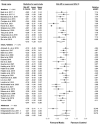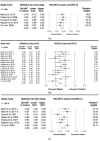Music Intervention for Pain Control in the Pediatric Population: A Systematic Review and Meta-Analysis
- PMID: 35207263
- PMCID: PMC8877634
- DOI: 10.3390/jcm11040991
Music Intervention for Pain Control in the Pediatric Population: A Systematic Review and Meta-Analysis
Abstract
Music intervention (MI) has been applied as an effective adjunctive treatment for pain control in various clinical settings. However, no meta-analysis has yet been published on the analgesic effects of MI in infants and children. We performed a systematic review of PubMed, EMBASE, Web of Science, and Cochrane Library databases to identify randomized controlled trials (RCTs) with the keywords "pain" AND "music therapy" from inception to January 2022. Primary outcomes were pain intensity and vital signs. Standardized mean difference (SMD) values and the corresponding 95% confidence intervals (CIs) were computed using a random effect model. Subgroup analyses with age groups, types of pain, and music styles were conducted. A total of 38 RCTs involving 5601 participants met the selection criteria. MI significantly decreased the pain levels (SMD = -0.57, p < 0.001), both in the newborn group (p = 0.007) and in the infant/children group (p < 0.001). MI significantly reduced heart rate (SMD = -0.50, p < 0.001) and respiratory rate (SMD = -0.60, p = 0.002) and increased peripheral capillary oxygen saturation (SMD = 0.44, p < 0.001). In subgroup analyses of types of pain, MI had significant effects on prick pain (p = 0.003), chronic and procedural pain (p < 0.001), and postoperative pain (p = 0.018). As for music styles, significant analgesic effects were observed for classical music (p < 0.001), kids' music (p < 0.001), and pop music (p = 0.001), but not for world music (p = 0.196), special composition (p = 0.092), and multiple music combinations (p = 0.420). In conclusion, our analysis provides supportive evidence about the efficacy of MI, especially classical, kids', and pop music, in controlling prick, procedural, and postoperative pain in the pediatric population.
Keywords: children; infant; music intervention; pain control.
Conflict of interest statement
The authors declare no conflict of interest.
Figures





Similar articles
-
The Effect of Music Distraction on Dental Anxiety During Invasive Dental Procedures in Children and Adults: A Meta-Analysis.J Clin Med. 2024 Oct 29;13(21):6491. doi: 10.3390/jcm13216491. J Clin Med. 2024. PMID: 39518630 Free PMC article. Review.
-
The effectiveness of music on pain among preterm infants in the neonatal intensive care unit: a systematic review.JBI Libr Syst Rev. 2012;10(58):4600-4609. doi: 10.11124/jbisrir-2012-428. JBI Libr Syst Rev. 2012. PMID: 27820525
-
Effects of music therapy on anxiety: A meta-analysis of randomized controlled trials.Psychiatry Res. 2021 Oct;304:114137. doi: 10.1016/j.psychres.2021.114137. Epub 2021 Jul 25. Psychiatry Res. 2021. PMID: 34365216 Review.
-
Psychological interventions for needle-related procedural pain and distress in children and adolescents.Cochrane Database Syst Rev. 2018 Oct 4;10(10):CD005179. doi: 10.1002/14651858.CD005179.pub4. Cochrane Database Syst Rev. 2018. PMID: 30284240 Free PMC article.
-
Effect of Music Therapy on Pain After Orthopedic Surgery-A Systematic Review and Meta-Analysis.Pain Pract. 2020 Apr;20(4):422-436. doi: 10.1111/papr.12864. Epub 2020 Jan 9. Pain Pract. 2020. PMID: 31785131
Cited by
-
Music as an Adjuvant Therapy in Postoperative Pain and Physiologic Parameters: Pre-Test, Post-Test Intervention Study.Rwanda J Med Health Sci. 2023 Nov 30;6(3):290-302. doi: 10.4314/rjmhs.v6i3.3. eCollection 2023 Nov. Rwanda J Med Health Sci. 2023. PMID: 40568645 Free PMC article.
-
[Evidence-based guideline for neonatal pain management in China (2023)].Zhongguo Dang Dai Er Ke Za Zhi. 2023 Feb 15;25(2):109-127. doi: 10.7499/j.issn.1008-8830.2210052. Zhongguo Dang Dai Er Ke Za Zhi. 2023. PMID: 36854686 Free PMC article. Chinese.
-
Multisensory stimuli and pain perception in the newborn.Pediatr Res. 2024 Feb;95(3):603-604. doi: 10.1038/s41390-023-02833-6. Epub 2023 Oct 13. Pediatr Res. 2024. PMID: 37833529 Free PMC article. No abstract available.
-
Severity and associated factors of postoperative pain in paediatric surgical patients aged 2 months-7 years at selected Addis Ababa Public Hospitals: a multicenter prospective longitudinal study.Ann Med Surg (Lond). 2024 Jan 17;86(3):1275-1282. doi: 10.1097/MS9.0000000000001742. eCollection 2024 Mar. Ann Med Surg (Lond). 2024. PMID: 38463099 Free PMC article.
-
Effect of music intervention on subjective scores, heart rate variability, and prefrontal hemodynamics in patients with chronic pain.Front Hum Neurosci. 2022 Nov 17;16:1057290. doi: 10.3389/fnhum.2022.1057290. eCollection 2022. Front Hum Neurosci. 2022. PMID: 36466624 Free PMC article.
References
-
- Inal S., Şahiner N.C. Using of distraction methods on procedural pain management of pediatric patients. Sağlık Bilimleri Ve Mesl. Derg. 2015;2:372–378. doi: 10.17681/hsp.47420. - DOI
-
- Bonutti P.D., Daré M.F., Castral T.C., Leite A.M., Vici-Maia J.A., Scochi C.G.S. Dimensioning of painful procedures and interventions for acute pain relief in premature infants. Rev. Lat. Am. De Enferm. 2017;25 doi: 10.1590/1518-8345.1387.2917. - DOI
LinkOut - more resources
Full Text Sources
Research Materials
Miscellaneous

